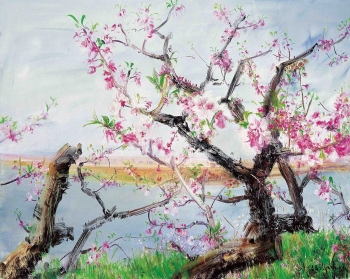EXHIBITED:
Zhou Chunya New Painting Solo Exhibition, Myhumblehouse, Taipei, March 22 - April 13, 2008
ILLUSTRATED:
Zhou Chunya New Painting Solo Exhibition, Myhumblehouse, Taipei, 2008, color illustrated, pp. 50-51 & p. 64
Catalogue Note:
After 2000, Zhou Chunya, who was best-known for his colorful "green dog" series of paintings at that time, began to pursue the style of abstraction art. His paintings of abstract art echoed his early works such as his "Stone", "Body", and "Landscape" series. Zhou entered a phase of pursuing new artistic experiment and transformation. Gradually, the peach blossoms became an important or even dominant element of his paintings. At the beginning (1997), the peach blossoms were rendered as the symbol of tenderness and beauty in Zhou's works, creating a strong visual impact when juxtaposed with the subject of the paintings, the wolf dog. Zhou said he was much fascinated by this experiment. Anyone who has understanding of Chinese traditional culture knows, that the followers have some erotic symbolic meaning in the Chinese symbolic world. But Zhou has his own way to tell erotic stories, namely using feminine "tenderness" as a foil to the masculine subject, so as to express the attractiveness of sexual scenes. In Zhou's works, the red human body is a recurring erotic motif. To maximize the attractiveness of sexual scenes, Zhou retuned to the Chinese ancient tradition of conveying erotic scenes, namely fusing tender feeling with violence, or highlighting tender feeling as an end in the exercise of violence, as violence is always a counter motif of tender feelings. In Zhou's own words, "the change of the subject of his paintings from the wolf-dog to peach blossoms relects a transformation from 'violence' to 'tenderness'". Actually, Zhou tries to use maximum "tenderness" to reinforce beautiful "violence" by borrowing the images of Chinese traditional paintings. (Peach Blossoms and Moon of New Paintings-Zhou Chunya's Art Career by Lu Peng)
Zhou likes the purity of plants and animals very much. His inspiration to create the "Peach Blossoms" series of paintings is sourced from his personal experience of watching peach blossoms in Chengdu. "I do love things with strong vitality. One spring when I went to a flower mountain near Chengdu to watch peach blossoms, I was much impressed by the sea of pink peach blossoms full of a primitive life force. From that moment I decided to create my "Peach Blossoms" series of works." said Zhou
The flowers are common painting objects of Chinese traditional paintings. In Zhou's "Peach Blossoms" series of paintings we can find some trace of Chinese traditional lower paintings. But by employing ever-changing colors, Zhou presents the peach blossoms on his canvas in a more dissolute and coquettish image. The image of peach blossoms symbolizes the coming of the spring season; in a broad sense, it also symbolizes love and sex. In Zhou's works, the light red color of the peach blossoms represents the very nature of erotic love. These works are filled with cultural meanings, transfiguring the primitive or even savage sex impulse to a very elegant and complicated image. The peach blossoms also represent the painter's mood. In a world full of blossoming peach trees, the painter's mood becomes totally liberated. The images of peach blossoms in Chinese traditional culture are attuded to sex and reproduction, but in Zhou's works, the image of peach blossoms as the symbol of erotic love is presented in a more bold and apparent manner. In addition to a dissolute and coquettish image of peach blossoms, Zhou usually adds the image of men and women in red who are making love under the peach trees into his paintings. "What I paint is 'sex and love', the instincts of human beings. The blossoming peach flowers are strangely juxtaposed with the men and women who are making love under the peach trees. This juxtaposition destroys the obstruction between human beings and nature as well as obscuring the boundary between moral and evil. In floating colors a world of fantasy has been created where the instincts and nature of human beings are fully liberated and released in a tender and also violent manner." Zhou said. The image of blossoming peach flowers expresses an unrestful mood between lourishing and withering. As time passes, we grow old with growing regret and resentment.
Zhou's "Peach Blossoms" series demonstrates an artistic style between the traditional and the avant-garde. He displays the tension between tradition and modern in a natural way by incorporating the form of western art and the spirit of oriental culture.
The painting entitled "Peach Blossoms Dancing in Spring Wind" portrays spring scenes. Zhou employs the colors with very strong visual impact and the rushed strokes of untamed passions. White in the peripheral part and red in the central part, the peach blossoms are blooming in profusion, demonstrating an ambiguous mood of temptation. Zhou prefers brilliant colors. He intentionally adds a large quantity of painting oil into pigments, letting them float freely on the canvas, thus producing the accidental effects of Chinese traditional calligraphy on the canvas. This painting is designed to create a hidden narrative, suggestive of the life passage in the garden, in which a living thing will experience desperation, joy, pain, longing, and other feelings. It evokes our thinking about the natural order and the fate of human beings.
In Zhou's "Peach Blossoms" series of works, we can find some inherent unity in Zhou's artistic creation. On the one hand, Zhou consistently seeks illumination from the Chinese painting tradition and imports the concepts and elements of Chinese traditional paintings into his works; on the other hand, Zhou presents his own perception of and judgment on cultural reality based on his personal experience and feeling. It should be mentioned that Zhou always stands outside current art fashions and consistently adheres to his unique artistic pursuit. This may be the reason why he is highly valued by other painters and art critics.
